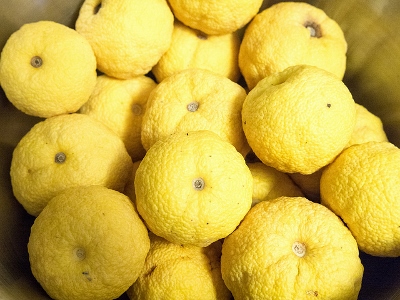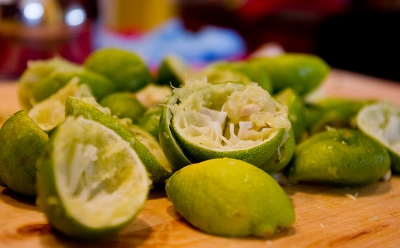The New Orange: 6 Funky Citrus Fruits You Should Know
I have always been a big fan of citrus. Sometimes it’s puckeringly sour; sometimes it’s sweet; it’s always a good source vitamins, and it livens up a glass of water (or a cocktail). But if you look beyond the usual suspects, you’ll see that there is a wide variety of citrus fruit out there. Some are vibrantly colored, while others look bruised when they’re ripe; some are smooth and easy to peel, while others look like the squid beast of your nightmares. To get you started on your citrus explorations, here are a few of my favorites.
1. Buddha’s Hand Citron
Also known as the “Fingered Citron,” Buddha’s hand is one of the oldest and creepiest members of the citrus family. It is believed that they were brought over from India to China sometime after the fourth century A.D. Today, in China and Japan, this unsightly citrus variety represents happiness and long life; they’re often displayed in temples and homes for good luck. While they haven’t gone completely mainstream—they can’t handle cold weather or frosts—you can still find Buddha’s hands at specialty grocery stores.
Before you begin wondering how you’d ever peel this thing, the good news is you don’t. Buddha’s hands are 100% rind and pith; they contain no juice at all. The rind, though, is chock full of essential oils that are delicious in dressings and marinades. To use a Buddha’s hand, just cut off a “finger” and slice it into strips. Then you can candy them, put them to the Microplane or scare your friends.
2. Yuzu
Flickr/Edsel Little
Yuzu is also a pretty bizarre fruit. Generally yellowish-green, yuzu can have a bumpy rind, like a lemon with acne. Their flavor can be described as a mixture of lemons, oranges and grapefruits. They are also packed with vitamin C—about three times more than lemons.
While not entirely popular in the U.S., yuzu has been used in Asia for centuries. They grow in Tibet, Central China, Japan and Korea, and their zest and juice can be found in a multitude of Asian ingredients like ponzu sauce and even some miso soup recipes. Because of its refreshingly sour and floral bite, yuzu is excellent for vinaigrettes and cocktails. While it’s remarkably hard to find fresh yuzu in the grocery store, you can usually find its juice bottled for sale.
If you’re not into buying the juice, you can likely find it listed on the menu at restaurants, because chefs are into it. Chef Jean-Georges Vongerichten served Sour Cherry-Yuzu Bellinis at a pig roast, and at Ippudo in NYC, they top their edamame and shishito pepper with yuzu salt.
3. Key Limes
Flickr/Scott Akerman
You won’t be shocked when I tell you that Key limes were named for the Florida Keys. But you may be surprised to know that they are also known as the West Indian lime, and have been cultivated for thousands of years in Indonesia. From there, they traveled all over the Eastern Mediterranean and then to the West Indies, where Spanish explorers introduced them. They were grown in Florida as early as 1906, and today, most are grown in Mexico and Central America.
Key limes are generally smaller than a lime—like the size of a golf ball. They’re packed with citric acid (more than lemons), which gives them a very tart and bitter flavor. But this goes well with sweets, like Key lime pies, for example. And if you’re looking to go beyond the usual pie, try doughnuts or bars topped with coconut.
4. Clementines
Flickr/Rebecca Siegel
-

-

-

-

-

-

-

-

-

-

-

-

-

-

-

-

-

-

-

-

-

-

-

-

-

-

-

-

-

-

-

-

-

-

-

-

-

-

-

-








































